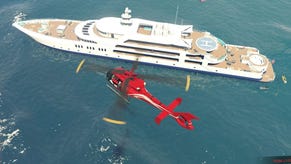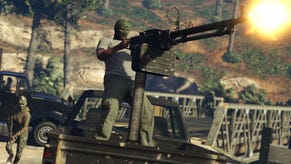"I could not be happier": Fargo on fans as publishers
Free from the dictates of tradition-bound publishers, inXile boss Brian Fargo is answerable to at least 74,00 bosses, and as our huge GDC 2013 interview reveals, he wouldn't have it any other way.
The beauty of crowd-funding
After acquiring the rights to Wasteland back from Konami in 2003, inXile Entertainment founder Brian Fargo announced in 2007 he was planning to bring back the game which inspired the original Fallout.
Then, all went quiet until that fateful day in February 2012 when Fargo announced Wasteland 2 would soon be up for crowd-funding. On March 13, 2012, the Kickstarter page for Wasteland 2 went live with $900,000 needed to fund development. Within 43 hours, the goal was surpassed, and when dust cleared on April 17, Wasteland 2 had raised over $2.9 million.
It was the third highest crowd funded game on Kickstarter at the time, and an additional $107,152 was donated through PayPal pledges.
Due to such overwhelming success, in January 2013, inXile decided to try its hand at Kickstarter again: this time, with the spiritual successor to Planescape: Torment, Tides of Numenera after the acquisition of the Torment license. The firm was understandably nervous doing so, as it would be the second project it posted to the crowd funding site within a year's time.
Such trepidation seemed to be justified when funding for the project seemed to stagnate at one point - before it took off like a rocket and became the second largest gaming Kickstarter to date.
"The first time around, with Wasteland 2, there wasn't enough data to signify to me [stagnation] was normal," inXile founder Brian Fargo told me during GDC. "So we thought we were in the middle of a drop-off, but we were wrong. We were like, 'what happened?' But we soon found out it's a very natural progression.
"I read that 87% of Kickstarter projects are small, and I think that in the beginning, someone said only half of the projects were getting financed and only one quarter of those were video games. That's insane. I mean, if you are out pitching products to publishers, maybe 1% of those are successful. This means that the successful one quarter on Kickstarter being financed brings that figure up to 20-25%. That is a huge statistic."
"Kickstarter is maturing and helping vet projects what wouldn't have sold. There is always a concept people will get behind. You just have to figure out what it is."
With so many games and hardware options being financed through Kickstarter, many have predicted that the bubble is going to burst. While such a thing could be construed as inevitable, it's not hard to suspect things are indeed slowing down, what with projects from high-profile developers either barely scraping by or failing to meet funding goals. Two such titles comes to mind off the top of my head: 22Cans' Godus which we all thought at one point wasn't going to make it, and Robotoki's The Adventures of Dash, respectively.
"For a while all I heard about was Kickstarter fatigue or that it wasn't going to happen or whether we should do another one," said Fargo. "And I thought, if I can provide compelling reasons why and give people more detail – I mean you'll notice the Torment pitch video was way more detailed than Wasteland 2 , and that's because the expectations were different than a year ago. Just a year made a difference. But we took more time with the Torment pitch and if you are really striking the right chords and personifying and people understand why they should support a project with their money, I think Kickstarter will continue to do well."
Fargo believes many Kickstarter projects fail due to pitches which don't follow "the golden rules," such as those that only show game footage. For a developer trying to get their game funded, such lack of attention to detail can make or break them. Backers need to know the developer: their background; their goals; their intentions with the title; why they have taken to Kickstarter in the first place instead of going the traditional route.
"I could never have raised money from the venture capitalists to do what I’m doing. It just wouldn't have happened. Kickstarter is still in a growth period. Like all entertainment mediums, the filtering is going to get tighter."
An example of one Kickstarter project which failed was the Fire Emblem-style tactical RPG, Telepath Tacitics. However, according to Fargo, the reason the title is once again back on Kickstarter, and successful this time, is because its developer learned from the previous failure.
"Look at Craig Stern: he went onto Kickstarter with Telepath Tactics and failed, yet people liked what they saw and knew he was a bright guy," Fargo said. "So, he made another run at it and he's funded this time. He learned and proved himself through failure, and came back and made it happen.
"I believe with the indies that if they are persistent and they show something they will start to have people recognize their talent and will have a chance to make it. They have to keep going. There is no other way. It's just not as easy as it was that first year of Kickstarter when everything was going wild – it was like when the Internet exploded and everyone was becoming a millionaire."
Fargo believes Kickstarter isn't a trend. It will continue to be a source of funding; however, it has matured and is no longer going through its "unnatural" first phase.
"It's maturing and helping vet projects what wouldn't have sold," he said. "I have friends with Kickstarters that didn't work out and, I tell them that people still like them, and like what they do - they just didn't care for that particular concept. They voted. They didn't like it. There is always a concept people will get behind. You just have to figure out what it is: there's so much psychology at work.
"I could never have raised money from the venture capitalists to do what I'm doing. It just wouldn't have happened. I don’t see it going away, its still in a growth period, it's just that like all entertainment medium, the filtering is going to get tighter. There are some developers who are trying to make Kickstarter their first project source. That's a hard way to cut your teeth production wise. I mean, for example: 'Here's a Flash game. Isn't it really great? Well now I am going to do this.' There are a lot of indies out there who have never produced anything before and say: 'give us money.' That's a harder conversation.
"Also, I think those products will be coming less and less, but that doesn't mean it will prevent the indie from finding a way to get their voice out there through Flash or Unity or whatever the case may be. I have been doing this for 30 years so I have a bigger voice, for these guys to be in my position later they have got to get something to market so that people can see them and start to build a fan base. "
Triple-A, the lack of indie support, and sexy heroines
Much has changed since Brian Fargo first's foray into the industry in 1982, after having been bitten by the video game bug with his first Apple II computer back in 1977. Fargo's first game released was the graphic text-adventure RPG Demon's Forge, which he developed and marketed himself as he worked on various educational games for World Book Encyclopedia.
By 1983, he had founded Interplay Productions where he developed another text-adventure game called Mindshadow which was published by Activision. Then came Bard's Tale for Apple II and Commodore 64 from publisher Electronic Arts. After finding success, Fargo co-designed Wasteland and in 1988 Interplay became both a development studio and publishing house.
Interplay published Silicon & Synapse's RPM Racing, developed by Ayman Adham and Michael Morhaime - who eventually changed their name to a Blizzard Entertainment. Other studios which found publishing deals under Interplay include Parallax Software, which was later renamed Volition, and even BioWare. Under Interplay's Black Isle division, Baldur's Gate, Icewind Dale and Planescape: Torment were released, as was the original Fallout.
During the mid-1990's, Universal/MCA had purchased a 45% stake in Interplay, and the firm went public in 1998. However, the firm's main investor Titus Software and Fargo had a difference of opinion on how to run the company, so in 2000 Titus took over control of Interplay, a move which caused Fargo to resign.
It's no wonder Fargo is less than trustful of large publishing firms, and is a huge supporter of indies. He started out as one; became entangled in big business politics and money; left for while; and now he's making a comeback on his own terms in an era where indie is taking on triple-A - and by all accounts succeeding.
Independent developers are younger, hungry, tired of the status quo, and ready to fight tooth and nail for a place in gamer's homes and handhelds.
"Look at the indie scene now compared to 2004. There was no Steam. There was no Kongregate. There was nothing for indies. It was the Dark Ages," he said.
"You have to look at the snapshot over the last decade rather than the last year. You've got consoles like OUYA and GameStick – you've got all these companies embracing them, you've got Sony, Steam, you've got Project Greenlight, Kickstarter, it’s so much better now than it was. There was nothing back then.
"In fairness, you've got to have some perspective regarding what's happened over this last decade to give so many more people a chance. I mean, there was literally nothing and there's not a lot of opportunity in the triple-A space for indies to go pitch publishers. It's almost non-existent. Thankfully we have these other vehicles now.
"I mean who would have thought a few years ago that Apple would come along with iPad and obliterate Nintendo. Who would have thought that would've happened?"
Fargo isn't shy when voicing his opinion on the triple-A scene, and since he is an independent developer, he doesn't have to worry about focus groups hired by larger publishers which dictate what sells and what doesn't sell in the marketplace, such as the idea of a video game having a female protagonist as a main character.
"I think people were overly influenced by Tomb Raider and being the sexy heroine. Now, that isn’t what is necessary or needed to make a game work."
Publishers have tried to force their ideas on developers - like Naughty Dog , a venerable developer which was asked to push Ellie to the back the box art for The Last of Us - with the suggestion that the game would not sell as well to what is deemed a predominantly male audience. Beyond: Two Souls developer Quantic Dream was also asked to show star Jodie Holmes brandishing a gun on the game’s cover. Both developers refused to budge. Dontnod were even told by publishers it pitched Remember Me to that female characters 'don't sell video games', before signing with on with Capcom.
This insistence that women don't work as protagonists, and serve merely as over-sexualised eye candy or romantic interest, is something Fargo blames on focus groups tested by marketing firms stuck in the glory days of Tomb Raider.
"This is my theory: I think people were overly influenced by Tomb Raider and being the sexy heroine," Fargo told me. "In Wasteland, we have a female character and she's a bad ass so I think that's more where [female protagonists] are going.
"I think that Tomb Raider kind of broke the mold in having a female heroine. But she was sexy, so I think there was a natural marketing inclination that thought: 'well that worked, so let's kind of stick with that formula.' Now, that isn’t what is necessary or needed to make a game work.
"I think we're finally seeing an evolution beyond the Tomb Raider, sexy-heroine-only sort of attitude. I think that that’s suggesting itself pretty quickly in this climate."
Going back to his roots
With Wasteland 2 and Torment: Tides of Numenera, Fargo and his team at inXile Entertainment are going back to their role-play roots after "not being able to develop," what they wanted, and instead, doing "everything else."
One such title the firm worked on in its early days, which was far from an RPG, was HEI$T for Codemasters: an open-world title set in San Francisco, California, circa 1969. In it, players controlled a group of criminals as they performed dozens of heists which would inevitably turn them into the greatest bank robber of all time. In addition to knocking off banks throughout the city, players would pull off further jobs such as raiding bars, restaurants, strip clubs, armored cars, and more in order to acquire the bigger and better tools needed to penetrate the increasingly more difficult banks and, eventually, the San Francisco Mint.
It sounded promising, but after being originally slated for release around Christmas 2007, in March 2008 Codemasters delayed the PC, PS3 and Xbox 360 title to June the same year. After the announcement, the game fell off the radar until it was revealed in 2010 that it had been cancelled. Codemasters said at the time the project had been "terminated" as the firm was shifting focus to "high quality titles that will, in the majority, be developed and produced," by its internal studios.
According to Fargo, the game had potential, and its troubled development cycle stemmed, in part, from too much publisher input.
"That was a game which had a lot of potential, and the writing was very Quentin Tarantino-ish. It had Christian Slater in it and he did wonderful job, he was very funny, " said Fargo. "But that was just another situation where the developer just needed to be left alone to do their thing.
"It's tough to be a developer, and on that particular project, we had an agreement where we would create an open-world game using Unreal Engine on the PS3 - but the specs didn't exist yet. So, at that point you're guessing and then when you finally get there you find there's a performance issue and you say: 'eh, let's just drop it. We can make it run great on PC and Xbox – but [Codemasters wanted] PS3.
"We didn't know about the RAM issues or performance issues with Unreal on the console. We had no idea, and you just go round and round in conversations that get nowhere. That's the thing about being a developer. There's this difficult relationship [with the publisher] that's unnecessary, and I find that the developers who are doing the best work have the ability to get paid on a regular basis and focus on what they're doing - and that's the beauty of doing a Kickstarter project.
"Because I can tell you as an executive of a company, you are spending 30-100 % of your time worrying about keeping all your guys employed. So what's next? Pitches, production, everything takes 6-9 months. So when you half way through developing one, game you are already pitching another product. You are not spending all of your energy just focusing on the game - whereas with Wasteland and Torment all I am doing is worrying about the game. This allows me to make a better game. It sounds simple, but it's a very important dynamic."
Plus, with Kickstarter, the project's backers are basically not only investors, but they can also be considered the publishers: this makes for a much more understanding and flexible "boss" if you will.
"The dynamic with the people who donate is much different [than working with investors], " said Fargo. "Like with Wastelands 2, they were asking 'when are we going to see the demo?' It ended up being about four weeks later than planned, and they were like 'no problem'. We delivered and everyone was happy.
"There also wasn't the threat of: 'if you don't deliver the demo you don't get paid.' It's a great dynamic. I could not be happier about being in a position to where the consumer who wants the game is also the one who helped fund the game. 100% of our interests are in line. I could not be happier."
Big thanks to The_Red for reminding me to ask Fargo about HEI$T.











